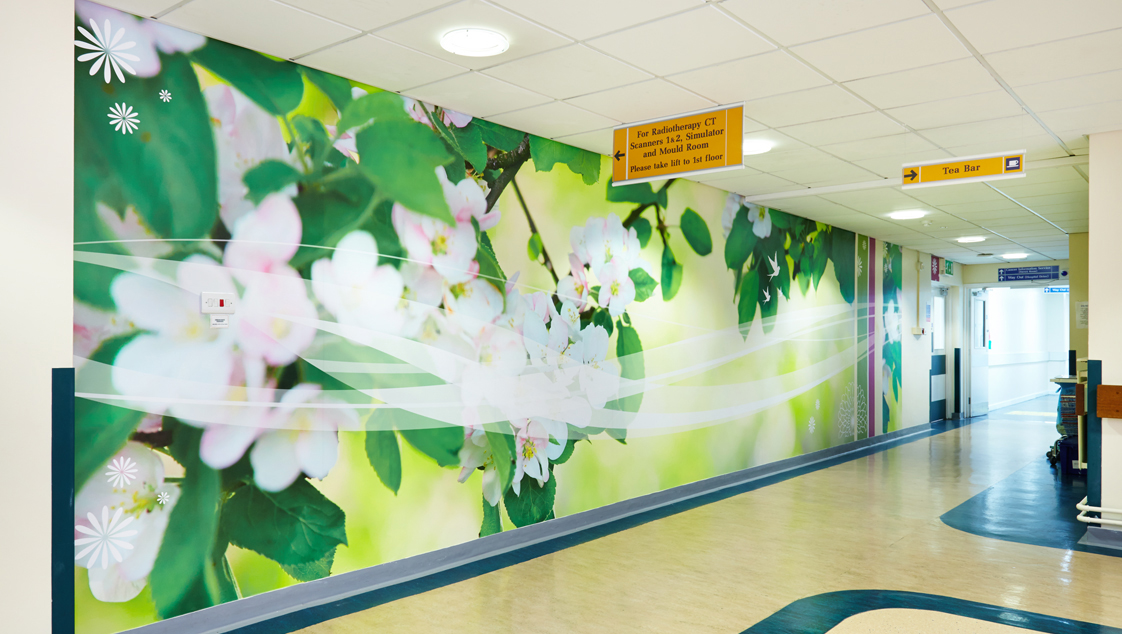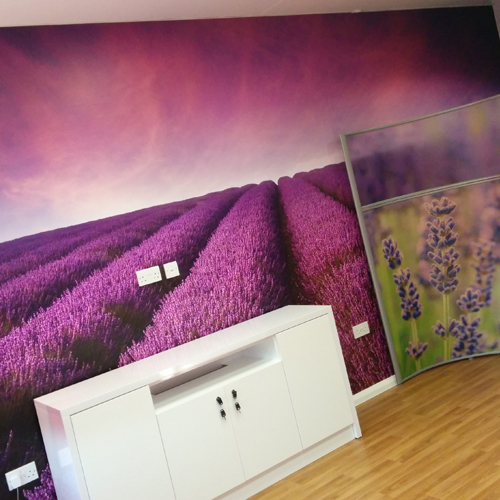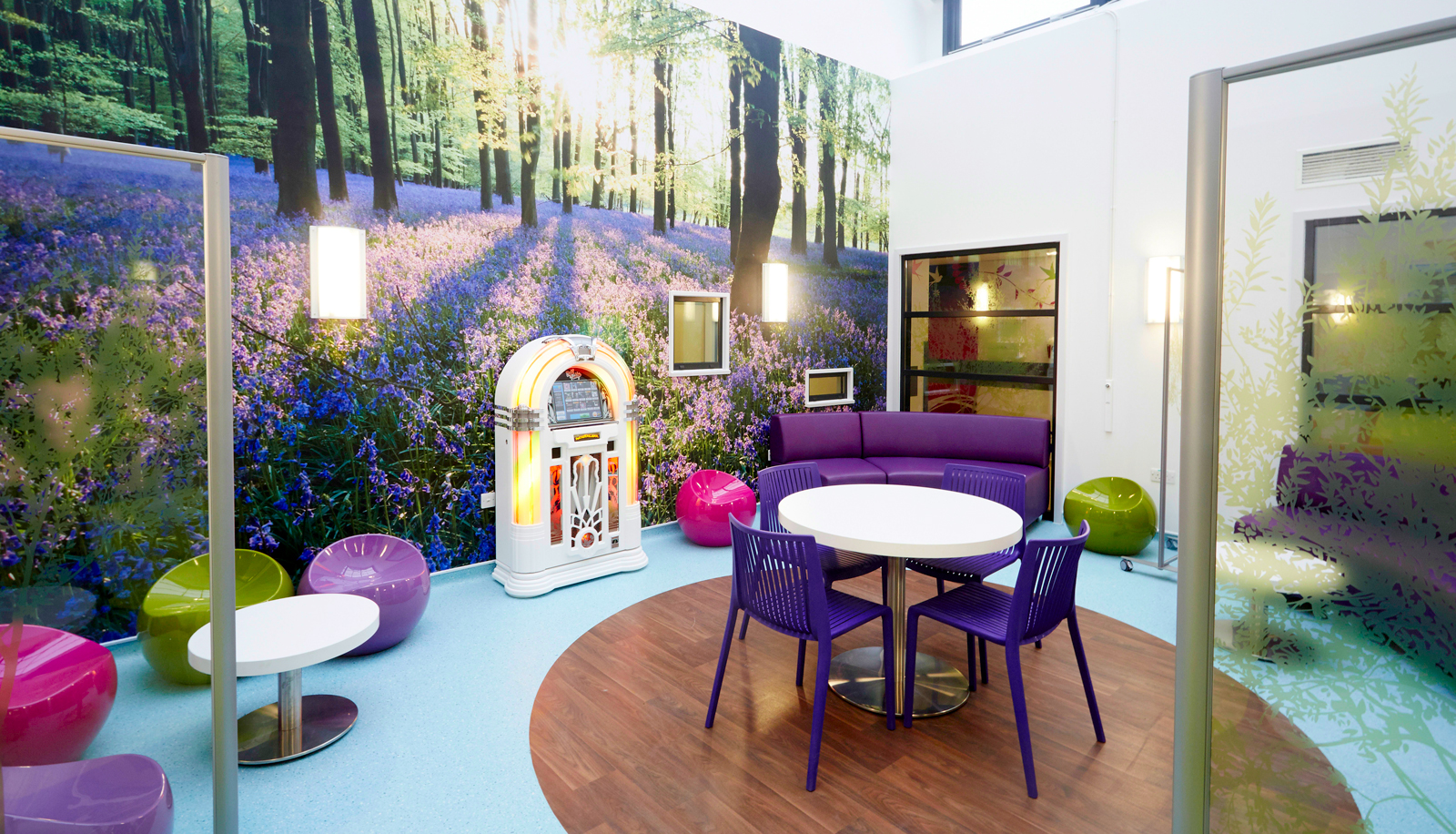
When we started working in healthcare in 2008 we never really knew the importance of the work we were doing. In fact we just printed and installed some stickers as we have done numerous times before. As we increased the amount of work in healthcare, working with interior designers, we started to hear how great our work was. At the time we took it as a compliment and little more. However years later we’re beginning to understand there is a lot more to it than that.
Few people in healthcare would regard art as completely pointless, due to the fact that many of us like pictures in our homes. So it seems logical to install artwork into buildings we spend any length of time, though if questioned “why”, many would be unable to articulate a reason. Artwork in our homes though are selected for a reason, it may be a painting of a place we love, or a pet. Or just a beautiful photo that caught our eye, on that market stall one Saturday by the sea. These have an emotional connection for us, but when it comes to public or commercial buildings we cannot have the same kind of emotional connection, so why should we have artwork in public buildings?
We rarely think about artwork in healthcare situations in a medicinal context, as they would not appear to have any physical properties that would make sick people well. However we should view the benefits of artwork in a psychological context. The psychological benefits of the environment are proven to impact patient outcome. Robert S. Ulrich, a Professor at Chalmers University of Technology, Goteborg Sweden has published 48 papers on the impact of environmental psychology. In one of his recent papers using Stress as a measurable benchmark, Ulrich discusses the value of artwork in healthcare situations as instruments at reducing patient stress.
We first came across Ulrich when researching around Distraction Therapy. In this study he documented that patients recovering from Gallbladder surgery were placed in rooms on a recovery ward. Half the ward looked out onto some trees and half looked out onto a brick wall or building. His findings were that the patients with the room with a view of nature had less negative comments in their doctor’s note. They used less pain killers and they were discharged from the hospital quicker than those with a room facing the wall. This is shown to be due to the trees being a distraction from the patient’s situation, those without the distraction needed stronger pain killers and were more aware of sickness or headaches, which the nurses and doctors noted.

In his paper on supportive design Ulrich promotes the issues that reduce stress for patients, those are; A sense of control regarding their surroundings. Access to social support. Access to positive distractions. As we deal mainly with wall artwork, we will only discuss the final of those three stress reducing elements. Throughout our experience of working in most of the major hospitals in the UK we have become aware of that fact that the reactions to our wall graphics, to the subject of the artwork (which we will return to in a moment). The fact that any artwork is a distraction to patients, especially when positioned against the majority of hospital wards.
In his study Ulrich found that nature is the best for distraction, with a window being his main focus. However in the work we had been doing we often saw anecdotal evidence that there was value in images of nature. Until we read his recent paper this was an assumption based on feedback and logic, which fortunately has been proven correct. In one study, a Dentals Fefears Clinic hung a large mural of a natural scene in the waiting area, on the days the mural was in the waiting room, as questionnaire concluded, patients felt less stressed than when there was no mural. Heart rate measurements also showed the patients were less stressed and tense.
Artwork content is important and studies show that images of nature, as suggested above, are the best distractions. In one study a patient group was shown images of a landscape, images of a zebra looking at the camera and some abstract artwork. Neither the zebra or the abstract artwork produced a positive outcome. On further investigation, it would appear that we are hardwired to view natural scenes as comforting. Where abstract images make us uncomfortable as our brain has to work to try decipher the meaning of the artwork. The image of the Zebra was seen as ‘arousing’ as the animal was looking directly at the viewer. Patient’s viewing the serene images of water and landscapes had a lower systolic blood pressure than those viewing the Zebra or the ‘control’ of no image.
To also offer a balance point, artwork can be used negatively so it needs to be considered carefully. Artwork that is abstract, confusing, stimulating or arousing used in the wrong context can actually harm patient wellness. Studies show that in a psychiatric ward which was decorated with wall art, that patients had positive feelings to images dominated by natural subject matter like landscapes and flower vases. By contrast the abstract images, with content that was unclear, drew negative comments and some patients reported they disturbed them. Five of the artworks in this study had in fact been attacked more than once by the patients.
Whilst more research is needed into this field of work it is obvious that the value of wall art is not just in cost savings over full refurbishments, but also in the cost savings to the healthcare system where patients with less stress are able to get better sooner.
I have always been of the school of thought that the building does not just house the healthcare system, but that it can actually be part of the healthcare system. These issues are a movement in themselves, with Architects and Designers beginning to implement and understand the importance of the environmental psychological benefits, that these spaces can have.
For wall graphics in Hospitals speak to our exclusive healthcare partners Grosvenor Interiors
